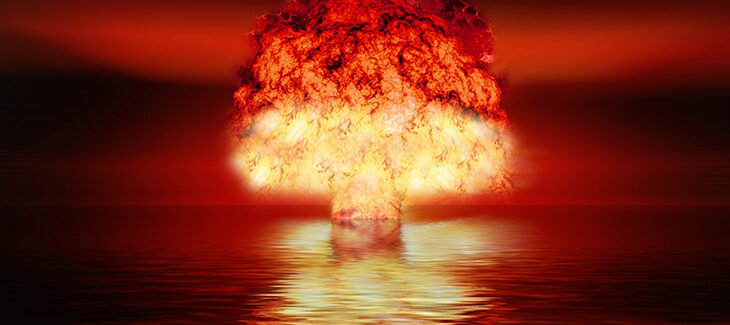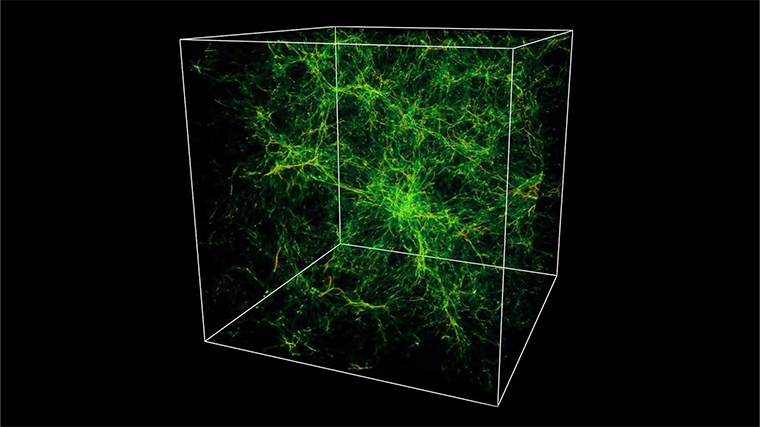I’ve always been amazed that tiny atoms hold significantly more energy than larger molecules. In molecules, there’s more energy than in an object with a vast number of atoms and molecules, such as a water mill or a catapult.
Let’s try to understand why.
On the macro level, gravity dominates
At the macroscopic level, gravity reigns supreme, under which kinetic energy or the energy of motion is released. Here are a few examples:
When water accumulates in a reservoir behind a dam, it stores potential energy due to the height it’s raised relative to the water outlet level. When the water is released through the dam’s turbines, its potential energy is converted into kinetic energy, which in turn is transformed into the mechanical energy of the spinning turbine and then into electrical energy by a generator.
When you lift an object to a certain height, it accumulates potential energy. When you release the thing, it falls under the force of gravity, and its potential energy turns into kinetic energy. This principle is used in mechanical clocks with weights or in old mills with falling hammers.
Transport vehicles moving downhill (like cars or bicycles) can utilize gravitational energy to increase speed or reduce fuel consumption.
In some energy storage systems, large weights are lifted to store energy and then lowered to release it. This process effectively converts electrical energy into potential gravitational energy and back again.
Every time we jump, our muscular energy is converted into potential gravitational energy at the peak of the jump. When we fall back to the ground, this potential is converted back into kinetic energy.
From these examples, it is clear that there’s an issue with energy limitation and scalability. The most we can extract comes from vertical drops, maximum wind or water speeds, by expanding and increasing the height and width of water flows. It’s complex, labor-intensive, and costly.
Chemical processes affect the bonds of molecules and atoms
It is well-known that gunpowder was invented in China. The first mention of a gunpowder-like mixture appeared in Taishang Shengzu Danjing Mijue by Qing Xuzi (around 808 AD) — it describes the process of mixing six parts of sulfur, six parts of saltpeter into one piece of charcoal (a plant that provided the mixture with carbon).
The atoms of molecules are linked together through a reaction known as chemical bonding. Credit: https://owlcation.com/
This invention elevated humanity’s energy capabilities to a new level.
One kilogram of gunpowder releases as much energy in a few seconds as a water mill with a water flow of 1 cubic meter per second in about half a minute.
In chemical processes, energy is released through changes in the bonds of atoms and molecules. This means that molecular bonds are more powerful than macro objects dependent on gravity.
In the 14th century, people mastered the industrial use of coal, and in 1858, the first commercial oil well was drilled. The energy from chemical processes greatly accelerated human progress.
Electric energy in batteries and accumulators is produced thanks to chemical reactions taking place inside them.
Gasoline, diesel fuel, coal, and natural gas contain chemical energy released in the form of heat when burned.
When detonated, substances like dynamite or TNT release a massive amount of energy due to rapid and exothermic chemical reactions.
Products such as ethanol or biodiesel, derived from plants or microorganisms, contain chemical energy that can be used as fuel.
Living organisms metabolize food to obtain energy for their vital processes. In digestion, complex molecules are broken down into simpler ones, releasing chemical energy.
Plants absorb light energy from the sun and convert it into chemical energy stored in glucose and other organic molecules.
It sounds strange, but from a conversion standpoint of mass into energy, humans appear much more potent inside at the chemical level compared to the macro level.
But this is not the limit.
The Power of the Atomic Nucleus
In nuclear reactions, the bonds between the elementary particles of the atomic nucleus change, releasing energy, which is also utilized. From the standpoint of the proportion of mass being converted into energy, it’s literally hundreds of thousands to millions of times more efficient than any chemical reactions.
An illustration of nuclear fission on the atomic level depicting atomic nuclei being split apart. (Image credit: marty8801/Getty Images)
It’s peculiar: the tiniest structural unit of matter, the atomic nucleus, can release a vast amount of energy. Indeed, when electrons transition between levels in atoms or molecules, power is usually released on the order of ~1 electron-volt. However, nuclear transition between different states can release energy that is a million times greater than this level, reaching ~1 mega-electron-volt.
Indeed, comparing the atom’s sizes and uranium’s nucleus demonstrates one of the most astonishing aspects of atomic structure: atoms are mainly composed of space. Atoms do not have clearly defined “borders”, but if we use the van der Waals radius (often used to describe the sizes of atoms), the diameter of a uranium-238 atom (U-238, the most common isotope of uranium) is roughly 186 picometers (pm) or 1.86 x 10^-10 meters.
Its nucleus contains 92 protons and 146 neutrons. The diameter of the atomic nucleus is typically measured in femtometers (or fermi, fm). Nuclei of heavy elements like uranium have a size of 15 femtometers (15 fm or 1.5 x 10^-14 meters).
Visually, it looks like this:
If we were to enlarge an atom to the size of a stadium, the nucleus would be the size of a marble (diameter 10-11 cm) in its center, while the electrons would “fly” around the stadium’s perimeter.
Viewing nuclear reactions in terms of mass conversion, it’s astonishing that an object with sizes measured in femtometers can possess such colossal energy.
However, the density of a typical atomic nucleus is around 2.5 * 10^17 kg/m^3, which is millions of times denser than the Sun or a supernova star and much denser than any material we encounter in everyday life. The nucleus’s density reflects a high-mass concentration in a small volume. Even minor changes in this mass can lead to the release of a significant amount of energy due to the relationship between mass and energy, described by Einstein in his famous formula.
Two Methods of Obtaining Nuclear Energy:
Energy can be derived from a nuclear reaction in two ways:
Splitting of heavy atomic nuclei in the process of nuclear fission.
Combining light nuclei in the process of nuclear fusion.
Elements lighter than iron release energy through thermonuclear fusion, while heavier elements do so through fission.
Both nuclear fission and fusion are associated with atomic bombs, where uncontrolled reactions continue to release energy as long as possible. Both also have other applications.
The diagram illustrates the chain reaction initiated when U-235 is hit with a free neutron. U-236 quickly forms and splits, releasing energy and three more neutrons. Uncontrolled, this leads to a bomb; controlled, it forms a nuclear reactor. (Credit: Fastfission/Wikimedia Commons)
Where is nuclear fission used?
Nuclear fission is used in various areas and for different purposes.
Most nuclear power plants worldwide use nuclear fission to produce energy. The nuclei of heavy elements, such as uranium or plutonium, split under the influence of neutrons, releasing a significant amount of energy, which is then converted into electricity.
Radioactive isotopes obtained from nuclear fission can be used to treat certain forms of cancer. This method is called radiotherapy.
Radioactive isotopes resulting from nuclear fission are used in the industry for quality control, measuring material thickness, and even for detecting leaks in pipelines.
Nuclear weapons are based on nuclear fission reactions (or, in the case of thermonuclear weapons, a combination of fission and fusion). While the use of nuclear weapons today is a matter of international treaties and prohibitions, it was historically deployed at the end of World War II.
Some deep-space missions use radioisotope thermoelectric generators (RTGs) that operate on the heat released during the decay of radioactive materials.
Thermonuclear Fusion
Thermonuclear fusion can release more energy compared to fission. This process occurs in all stars with a core temperature above ~4 million K and is the primary energy source of our Sun. The energy of a thermonuclear explosion significantly exceeds that of an atomic one; the former is measured in megatons, while the latter is in kilotons.
That’s why the energy from nuclear fusion is a dream for sustainable energy production.
Banner image: CC0 Public Domain
Image credit:
https://www.publicdomainpictures.net
https://owlcation.com
https://www.space.com






